
Posted on 05/12/2012 5:21:22 AM PDT by Homer_J_Simpson

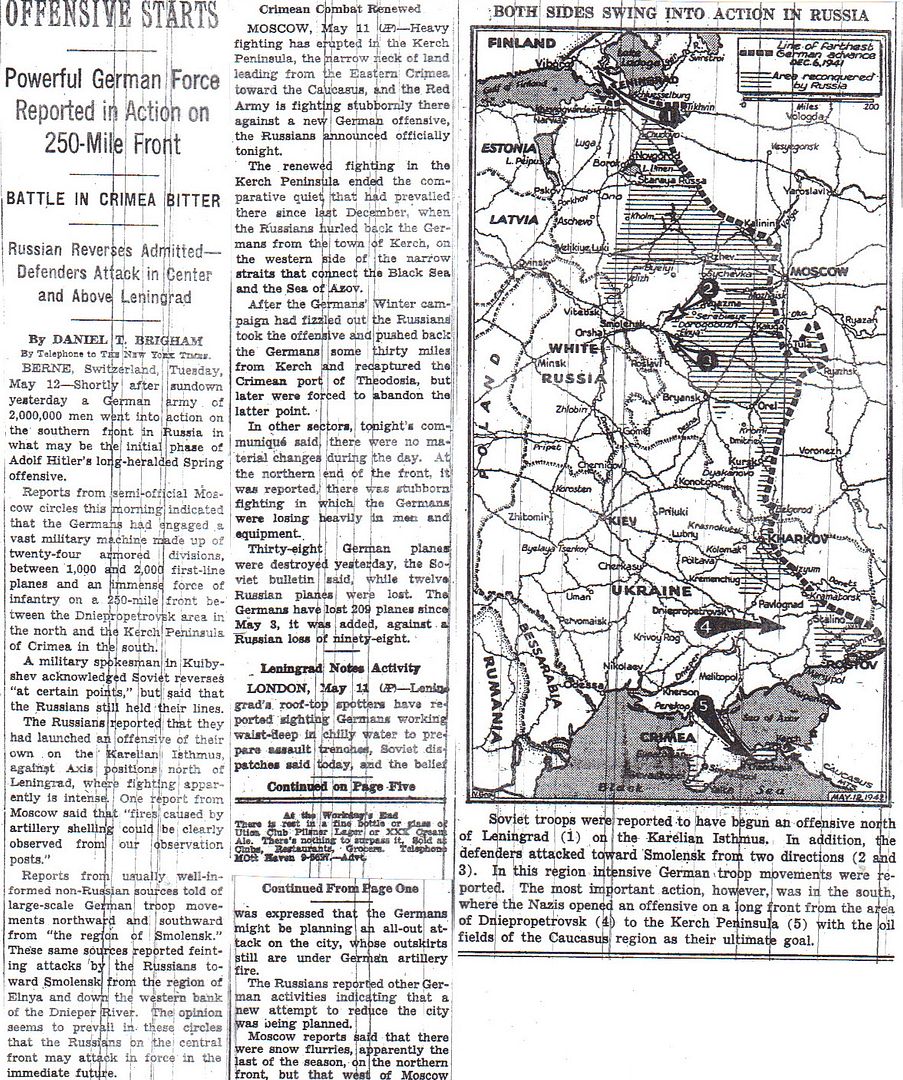
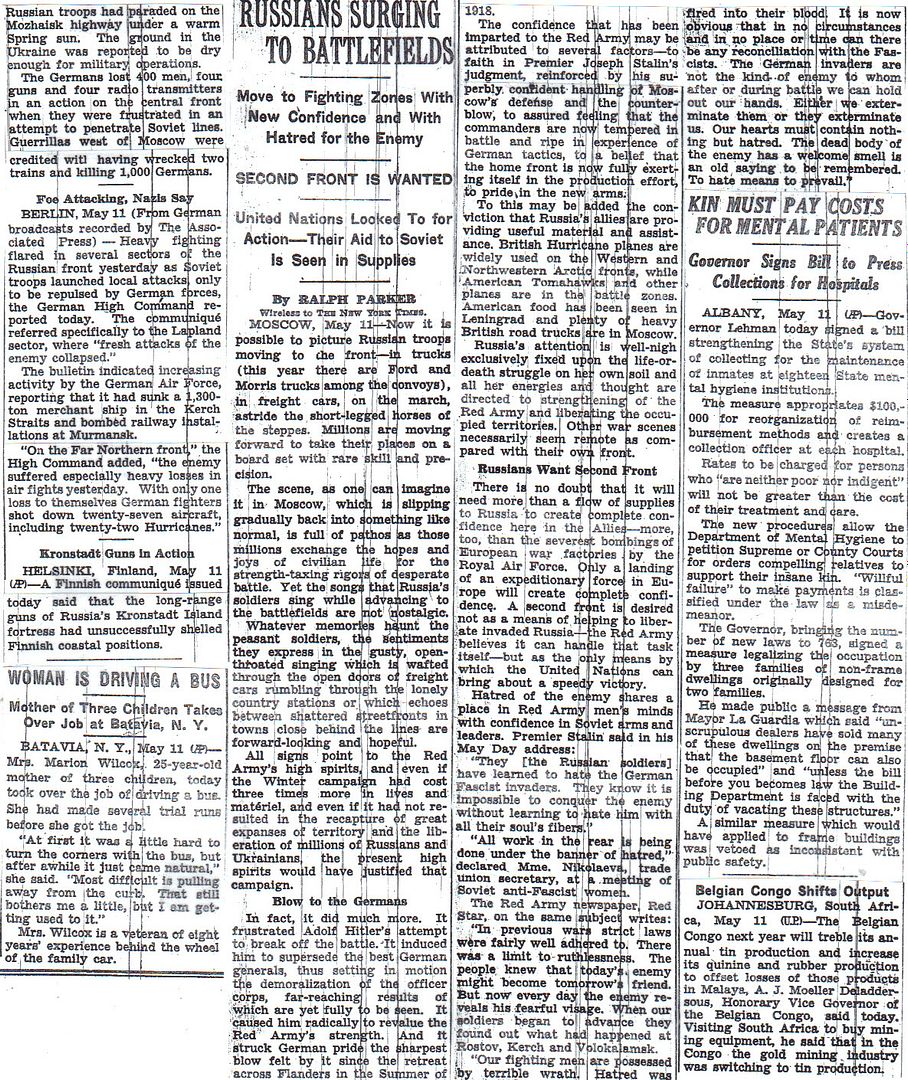
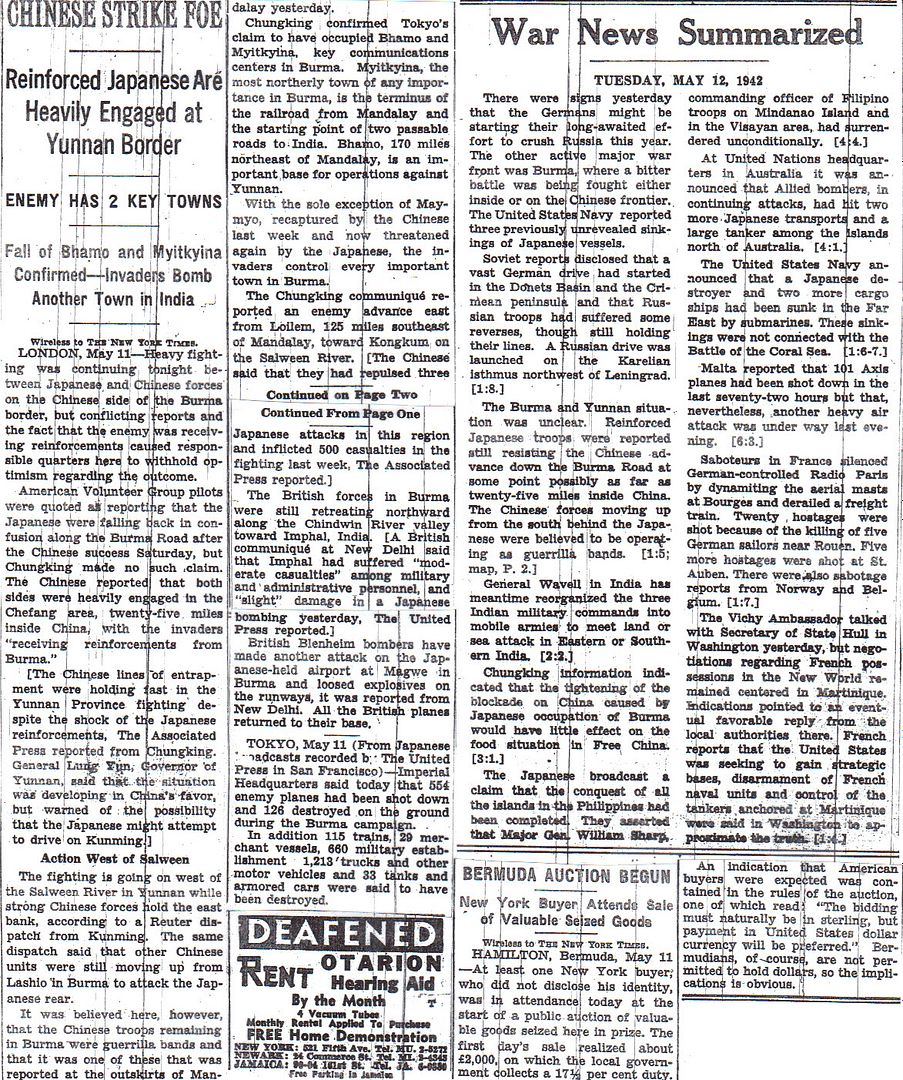
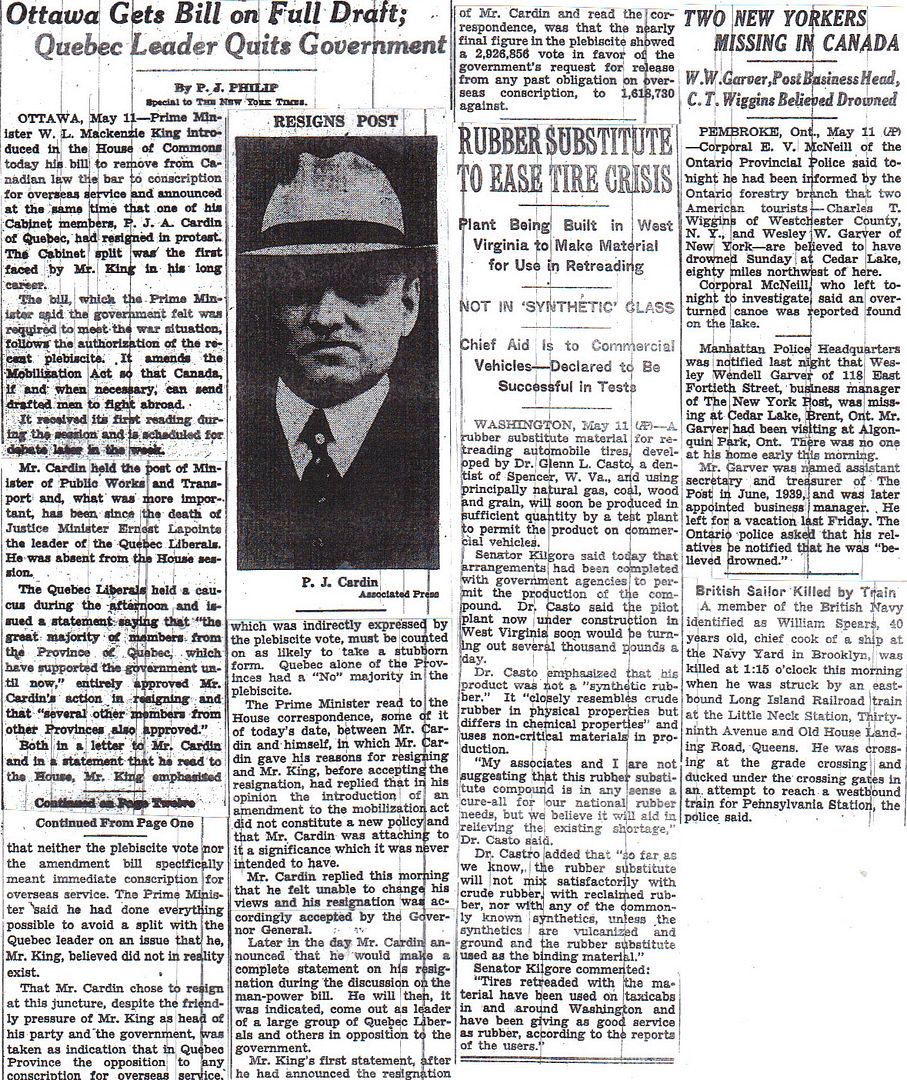

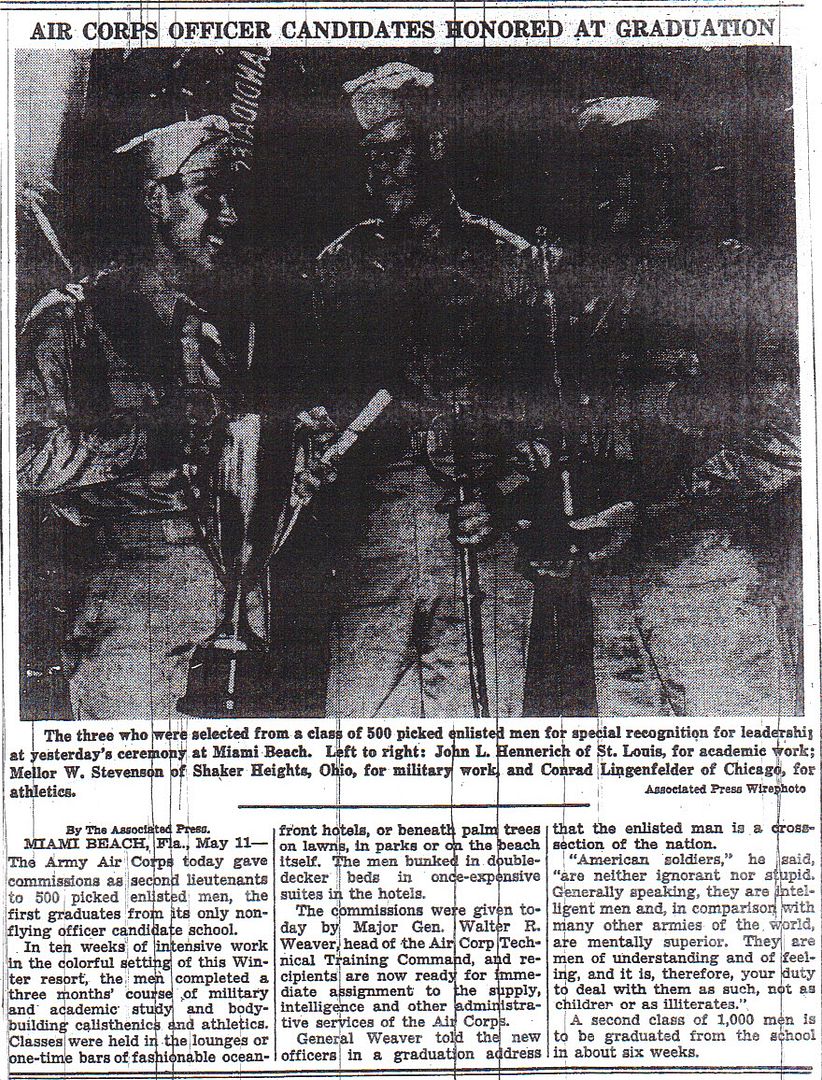
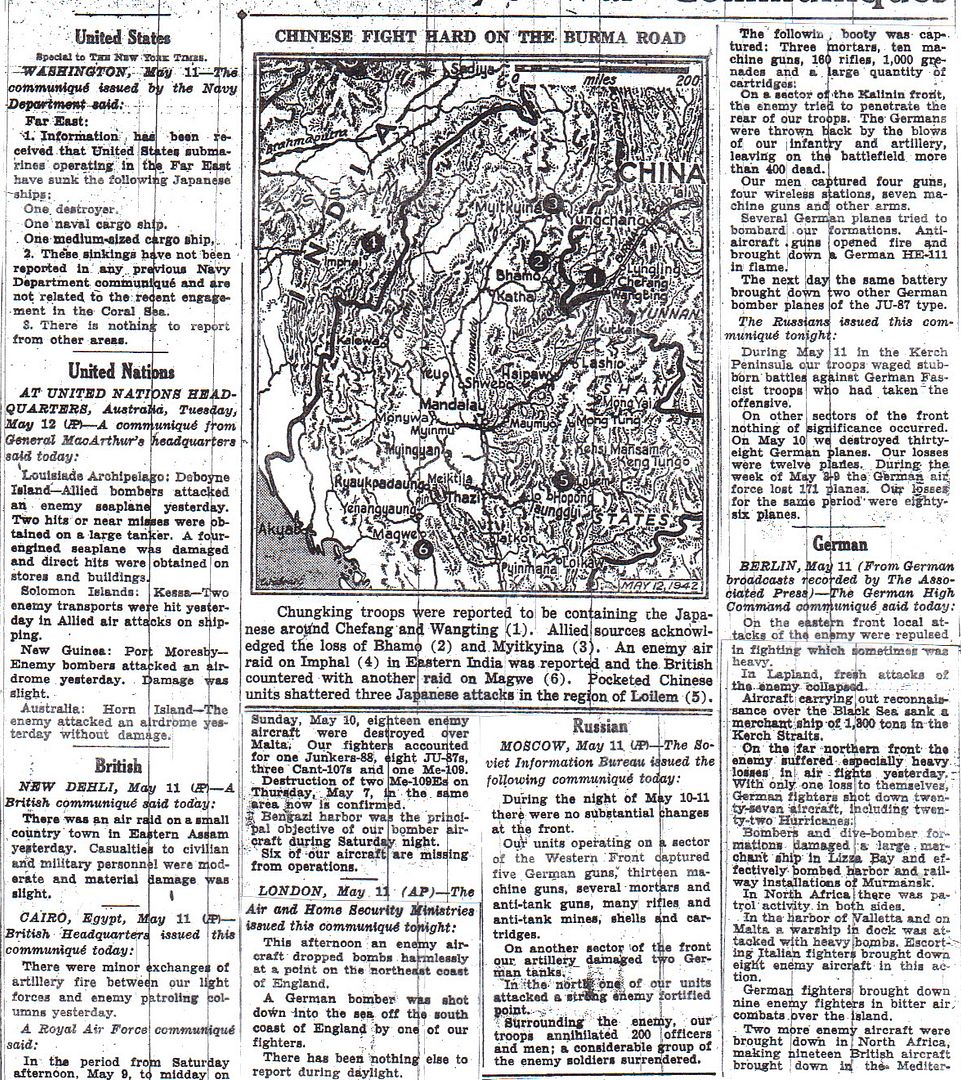
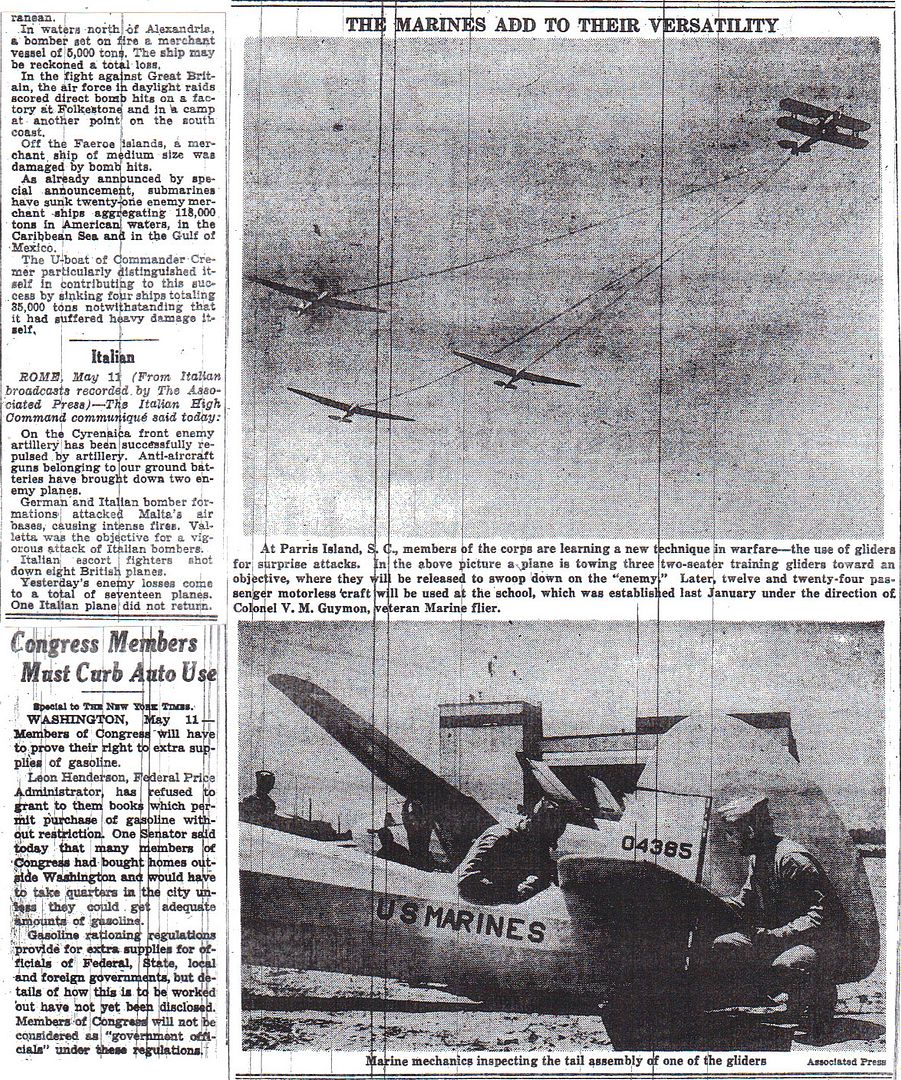
Offensive Starts (Brigham) – 2-3
Russians Surging to Battlefields (Parker) – 3
Chinese Strike Foe – 4
War News Summarized – 4
Ottawa Gets Bill on Full Draft; Quebec Leader Quits Government (Philip) – 5
Zionists in Accord in Meeting Here – 6
The Texts of the Day’s War Communiques – 8-9
The Marines Add to Their Versatility (photo) – 9
http://www.onwar.com/chrono/1942/may42/f12may42.htm
Red Army strikes toward Kharkov
Tuesday, May 12, 1942 www.onwar.com
Soviet T-34 tanks provide cover for the infantry [photo at link]
On the Eastern Front... Soviet attacks aimed at recapturing the city of Kharkov start. This offensive is a renewal of attempts to trap the German armies in the area against Sea of Azov (in January).
http://homepage.ntlworld.com/andrew.etherington/frame.htm
May 12th, 1942
UNITED KINGDOM: London: The man sent by the Warsaw Jews to tell the free world of Nazi genocide committed suicide today in London. Szmul Zygielboim left a letter in which he wrote: “I cannot live when the remnant of the Jewish people in Poland is being steadily annihilated ... By my death, I wish to express my vigorous protest against the apathy with which the world resigns itself to the slaughter.” Zygielboim was a leading member of the Polish Jewish Social Democratic Party. After escaping to England in 1940 he spoke and broadcast frequently on Jewish suffering under the Nazis.
Three more U.S. Coast Guard Lake-class ships are transferred to the Royal Navy. USCGC Champlain (CGC-48) is renamed HMS Sennen, USCGC Sebago (CGC-51) is renamed HMS Walney, and USCGC Cayuga (CGC-54) is renamed HMS Tortland. (Jack McKillop)
Submarine depot ship HMS Wuchang commissioned.
Destroyer HMS Limbourne launched. (Dave Shirlaw)
GERMANY:
U-540, U-742 laid down.
U-629, U-630, U-710 launched. (Dave Shirlaw)
U.S.S.R.: A two-pronged Russian attack on Kharkov begins. Marshal Timoshenko is attempting to trap German forces against the Sea of Azov.
Tonight the Soviet high command is claiming that the Red Army has broken the German line after one of the biggest tank battles of the war.
Torrential rain continues to hamper operations but the Russians are pressing westwards after the fleeing Germans. They have captured a great quantity of munitions assembled immediately behind the front in readiness for Hitler’s long-threatened summer campaign.
Marshal Timoshenko, conducting the Kharkov offensive, issued a rousing order to his soldiers before sending them into battle: “We have entered a new period of the war, the period of liberation of Soviet lands from the Hitlerite rabble.
“I hereby order the troops to begin the decisive offensive against our vilest enemy, the German fascist army, to exterminate its manpower and war materials and to hoist our glorious Soviet banner over the liberated cities and villages.” The Russian soldiers, fighting with their unusual dogged courage, have obeyed him to the letter. But some of his staff feel that they are advancing too quickly and fear a German trap.
ARCTIC OCEAN: Soviet submarine “K-23” of the Polar fleet and White Sea Flotilla is sunk - by surface ASW ships UJ 1101, 1109 and 1110, they used 8,8 cm. guns afterwards came a German aircraft and sank it, close to cape Nordkin, Oks-fjord area. (Torstein and Sergey Anisimov)(69)
(Sergey Anisimov)(69)Polar Fleet and White Sea Flotilla: Shipping loss. SKR-29 “Brilliant” - by aviation at Jokanga (later raised)
POLAND: Auschwitz-Birkenau: The first mass-killing takes place. The victims are 1500 Polish Jews. (Mikko Härmeinen)
MEDITERRANEAN SEA: The RAF shoots down 13 German troop-carrying aircraft off the North African coast.
INDIA: Minesweeper INS Madras commissioned. (Dave Shirlaw)
CANADA: Corvette HMCS Moncton arrived Halifax from builder Saint John, New Brunswick.
At 0828, the unescorted Leto was hit by one torpedo from U-553 about eight miles north of Cape de la Madeleine. The torpedo struck in the engine room, wrecking the engine, killing eleven men (including the first engineer) and causing the ship to sink in a short time. In Quebec, the ship had taken four maritime officers as passengers on board. They were from the Dutch motor tanker Oscilla, which had been sunk by the Italian submarine Morosini on 16 Mar1942. One of them, the first mate, was rescued from a piece of wood but died later of hypothermia.
At 0552, the unescorted Nicoya was torpedoed by U-553 in the Gulf of St Lawrence south of Antipasti Island and sank following a coup de grâce at 0611. Five crewmembers and one gunner were lost. The master, 62 crewmembers, nine gunners and ten passengers landed at Fame Point Lighthouse, Gaspe Peninsula, New Brunswick.
(Dave Shirlaw)
U.S.A.: The 16-inch battleship USS Massachusetts is declared ready for operations. (William Enestvedt)
Minesweepers USS Capable and Captivate laid down.
Destroyer USS Isherwood laid down.
Destroyer USS Parker launched. (Dave Shirlaw)
URUGUAY: The nation severs diplomatic relations with France. (Dave Shirlaw)
ATLANTIC OCEAN: German submarines sink two U.S. merchant tankers, the first off Louisiana and the second east of Barbados. (Jack McKillop)
ASW trawler HMS Bedfordshire torpedoed and sunk by U-558 off Cape Lookout, North Carolina. (Dave Shirlaw)
At 0355 and 0358, U-124 fired torpedoes at Convoy ONS-92 SE of Cape Farewell and hit Mount Parnes and Cristales. The Cristales was abandoned and later sunk by gunfire by corvette HMCS Shediac. The master, 64 crewmembers, seven gunners and ten passengers were rescued. 37 survivors, including seven passengers were picked up by the corvette and landed at St John’s on 16 May. The remaining 45 survivors were picked up by USCGC Spencer and landed at Boston. An escort vessel later scuttled Mount Parnes.
At 0156, 0159 and 0206, U-124 fired torpedoes at Convoy ONS-92 SE of Cape Farewell and observed hits on three ships. At 0222, U-124 made a second attack and observed one hit amidships after 1 minute 56 seconds. Mohr claimed three ships totalling 16,100 tons sunk. However, only two ships were hit at the time of the first attack, the Empire Dell and Llanover. The master, Hugh MacKinnon, 38 crewmembers and seven passengers (RAF personnel) from Empire Dell were rescued. 25 survivors were picked up by corvette HMCS Shediac and landed at St John’s on 17 May. 21 survivors were picked up by British rescue ship Bury and landed at St John’s on 16 May. Two crewmembers were lost. The badly damaged Llanover was scuttled by corvette HMCS Arvida. The master, 39 crewmembers and six gunners were picked up by Bury and landed at St John’s on 16 May.
Steam tanker Virginia sunk by U-507 at 28.53N, 89.29W.
At 0903, the unescorted Lise was first torpedoed by U-69 and then shelled. Twelve men were killed near the gun platform during the shelling and as it proved it fruitless to defend the ship, the crew got order to abandon ship. The master and the second mate jumped overboard and climbed into the gig that had been launched by the crew. At 1002, the tanker was hit by a coup de grâce amidships and sank. At daybreak the six men in the gig found a raft with seven men, while another lifeboat containing eight survivors searched for other survivors, but found none until daybreak, so they headed for land, reaching Carrizal in Columbia on 15 May. They went aboard the Norwegian merchant Washington Express and arrived at New York on 2 June. In the meantime, the master found that the gig was overloaded with all 13 men in it, so they decided to have a draw for a place in it. Five men had to go back to the raft and they later lost contact. On 13 May, the gig came near Curaçao and the men were rescued by the Dutch armed whaler Femern and taken ashore. A B-17 aircraft was sent out to look for the remaining survivors on the raft, but they were not found. On 31 May, another US aircraft located the raft in 14°38N/79°23W and directed the Dutch steam merchant Socrates to it, which picked up the survivors two hours later and landed them at Curaçao. On 7 June, the master, the five men from the raft and four others from the Lise left Curaçao on the Crijnssen for New York. The ship was torpedoed and sunk in the Straits of Yucatan on 10 June by U-504. All men from the Lise again survived being torpedoed. One Norwegian crewmen landed together with other survivors on the coast of Yucatan and was later flown to the USA. The Lebore picked up the master, eight crewmen and 40 others on 11 June, which was herself sunk by U-172 14 June. Again all nine Norwegians survived and abandoned ship on a raft. They were picked up two days later by USS Erie (PG 50) and taken to Cristobal. The first mate, Haugar Lyngås, later experienced a fourth torpedoing when Katy was torpedoed and sunk by U-857 23 Apr 1945.
SS Cocle sunk by U-94 at 52.37N, 29.13W.
(Dave Shirlaw)
Old Adolph turned out to be one of our BEST ALLIES!You could always count on him to bite off more than he could chew!
“The New York Slimes”!I don’t think it’s worth THREE-CENTS today!!!!!!!!!!!!!!!!!!!!!!!!!
Got a hunch this Soviet offensive is gonna be a MAJOR mistake.
Interesting that the Soviets have initiated the action around Kharkov from their Barvenkovo salient, and are now pressing the German 6th Army around Kharkov. Yet they are making press releases that indicate they are on the defensive against German attacks. At this point they have no reason to believe they will fail.
The page 1 article about Himmler’s disagreement with the Army re: sending SS ‘elite guard’ formations to the front is amazing. In 1941, the 1st SS Mot. Regt., LEIBSTANDARTE SS ADOLF HITLER, served with AG South. The 2d SS Division [Mot.], DAS REICH, served with AG Center. The 3d SS Div.[Mot.], TOTENKOPF, served with AG North.
Also serving on the Eastern Front were the 1st SS Cav. Bde., the 4th SS Div., POLITZEI, SS Bde. NORD, the 5th SS Div.[Mot.], WIKING, and other units. In other words, almost the entire combat establishment of the Waffen SS.
Where do they get this stuff?
Oh, and by the bye, Himmler is not head of the Gestapo. that’s Heinrich Mueller. Himmler’s two levels up: Reichsfuehrer SS and Chief of the German Police. And in between them is a chap named Reinhardt Heydrich, who runs RSHA, an amalgm of the Gestapo, Kripo [Kriminal Police] and the SS SD.
Kharkov-A Calculated Risk
"Three o'clock," said Second Lieutenant Teuber, a Company Commander in the 466th Infantry Regiment.
No one made any reply. What was there to say?
After all, it was a statement of fact. It meant that there were another five minutes to go.
In the east the Russian sky was turning a dark sinister red. It was a cloudless sky. There was complete silence—so much so that the men's breathing could be heard.
And also the ticking of the second lieutenant's large wrist-watch as he supported his hand against the edge of the trench. The seconds were ticking away —drops of time into the sea of eternity. Unknown to some of the young soldiers in the trench that ticking watch was counting down the last minutes of their lives.
At last the moment had come. A roar of thunder filled the air.
To the new soldiers on the battlefield it was just an unnerving, deafening crash, but the old soldiers of the Eastern Front could distinguish the dull thuds of the howitzers, the sharp crack of the cannon, and the whine of the infantry pieces. From the forest in front of them, where the Soviets had their positions, smoke was rising. Fountains of earth exploded into the air, tree-branches sailed up above the shell-bursts— the usual picture of a concentrated artillery bombardment preceding an offensive.
This then was the starting-line of the "Bear" Division from Berlin—but the picture was the same in the sectors held by the regiments of 101st Light Division, the Grenadiers of 16th Panzer Division, and the Jägers of 1st Mountain Division, the spearhead of attack of von Mackensen's III Panzer Corps. Along the entire front between Slavyansk and Lozovaya, south of Kharkov, the companies of von Kleist's Army Group were, on that morning of 17th May 1942, standing by to mount their attack under the thunderous roar of the artillery.
At last the barrage in front of the German assault formations performed a visible jump to the north. At the same moment Stukas of IV Air Corps roared over the German lines.
"Forward!" called Second Lieutenant Teuber.
And, like him, some 500 lieutenants and second lieutenants were, at that very second, shouting out their command: "Forward!"
The question which had been tormenting officers and men during the past few days and hours was forgotten—the great question of whether the German forces would succeed in striking at the root of the Russian offensive that had been moving westward for the past five days. What was happening on that 17th May?
What was the objective of the attack by Kleist's Army Group?
To answer this question we must cast our eyes back a little.
For the purpose of gaining a proper starting-line for the great summer offensive of 1942 from the Kharkov area in the direction of the Caucasus and Stalingrad, Fuehrer Directive No. 41 had ordered that the Soviet bulge on both sides of Izyum, which represented a permanent threat to Kharkov, should be eliminated by a pincer operation. For this operation the C-in-C Army Group South, Field-Marshal von Bock, had made a simple plan: the Sixth Army under General Paulus was to attack from the north, and von Kleist's Group with units of First Panzer Army and Seventeenth Army was to attack from the south. In this way Timoshenko's well-filled bulge was to have been pinched off and the Soviet Armies assembled in it annihilated in a battle of encirclement. The code word for this plan was "Fridericus."
But the Russians too had a plan.
Marshal Timoshenko wanted to repeat his January offensive, and therefore he had prepared an attack with even stronger forces, an attack he hoped would decide the outcome of the war.
With five Armies and a whole armada of armored formations he intended to strike from the Izyum bulge and, north of it, from the Volchansk area, where his January offensive had ground to a halt, and burst through the German front with two wedges. In a big outflanking operation the town of Kharkov, the administrative centre of the Ukrainian heavy industry, was to have been retaken. This would have deprived the Germans of their vast supply base for the southern front, a base where massive stores were situated.
Simultaneously Timoshenko wanted to repeat his earlier attempt of snatching Dnepropetrovsk from the Germans, as well as Zaporozhye, 60 miles farther on, with its huge hydroelectric power station which, in the forties, was a kind of eighth wonder of the world.
The huge Russian Hydroelectric complex at Zaporozhye-May 1942
The realization of this plan would have been even more disastrous to the German Army Group South than the mere loss of their rearward base of Kharkov. Through Dnepropetrovsk and Zaporozhye ran the roads and railways to the lower reaches of the Dnieper; the river here was more like a string of lakes, and between those towns and the Black Sea there was no further certain crossing over it. All supplies for the German Armies on the southern wing, for the forces east of the Dnieper in the Donets area and in the Crimea, had to pass through these two traffic centres. Their loss would have precipitated a catastrophe.
Thus in the spring of 1942 the attention of both sides was focused on the great bulge of Izyum, the fateful setting of future decisive battles for Bock as well as for Timoshenko. The question was merely: who would strike first, who would win the race against time—Timoshenko or Bock?
The German time-table envisaged 18th May as the day for the attack, but Timoshenko was quicker.
On 12th May he mounted his pincer operation against General Paulus's Sixth Army with surprisingly strong forces. The northern jaw of the pincers, striking from the Volchansk area, was represented by the Soviet Twenty-eighth Army with sixteen rifle and cavalry divisions, three armored brigades, and two motorized brigades. That was an overwhelming force against two German Corps—General Hollidt's XVII Corps and General von Seydlitz-Kurzbach's LI Army Corps—with altogether six divisions. Timoshenko's southern jaw struck with even more concentrated power from the Izyum bulge. Two Soviet Armies, the Sixth and the Fifty-seventh, pounced with twenty-six rifle and eighteen cavalry divisions, as well as fourteen armored brigades, against the positions held by General of Artillery Heitz's VIII Corps and the Rumanian VI Corps, Half a dozen German and Rumanian infantry divisions, initially without a single tank, were finding themselves faced by a vastly superior enemy attacking with colossal armored support. There was no hope at all of intercepting the Russian thrust at its two focal points. The German lines were over-run. At the same time, just as during the winter battle, numerous German strongpoints held out in the rear of the advancing enemy.
General Paulus employed all available units of his Sixth Army against the Russian torrent bursting through his lines. Twelve miles before Kharkov he eventually succeeded, literally at the last moment, in halting Timoshenko's northern prong by striking at its flank with the hurriedly brought up 3rd and 23rd Panzer Divisions and 71st Infantry Division.
But Timoshenko's tremendously strong southern prong, striking from the Izyum bulge, was not to be stopped. Disaster seemed imminent. The Russians pursued their breakthrough far to the west, and on 16th May their cavalry formations were approaching Poltava, Field-Marshal von Bock's headquarters, more than 60 miles west of Kharkov. The situation was becoming dangerous. Bock was faced with a difficult decision.
In two days' time "Fridericus" was due to start. But the Soviet offensive had completely changed the situation. General Paulus's Sixth Army was pinned down and engaged in desperate defensive fighting. As an offensive striking force it had therefore to be written off. This meant that a pincer operation had become impossible. Should he therefore drop the whole plan, or should he carry out "Fridericus" with only one jaw? Bock's Chief of Staff, General of Infantry von Sodenstern, was urging him to adopt the "single-prong" solution. In view of the enemy's strength it would be a risky move—but an argument in its favor was the fact that with every mile he advanced farther westward Timoshenko's flank was getting more dangerously exposed.
That was Bock's chance. And in the end the Field-Marshal decided to take it, He decided to carry out "Operation Fridericus" with only one arm. To deny the Russians the possibility of screening their long flank he even advanced the date of attack by one day.
Thus von Kleist's Group—now called an Armeegruppe, or an Army-sized combat group—mounted its attack in the morning of 17th May from the area south of Izyum with units of First Panzer Army and Seventeenth Army. Eight infantry divisions, two Panzer divisions, and one motorized infantry division constituted Kleist's striking force. Rumanian divisions were covering its left wing.
At 0315 hours Second Lieutenant Teuber leapt out of his trench at the head of his company and with his men charged the Russian positions on the edge of the wood. Stukas screamed overhead, diving and dropping bombs on identified Soviet strongpoints, dugouts, and firing positions. Some .2-cm. Army anti-aircraft guns on self-propelled carriages were driving along with Teuber's platoons, making up for their lack of tanks. Firing point-blank, these .2-cm. guns of Army Flak Battalion 616 slammed their shells into centers of Soviet resistance. The infantrymen were fond of this weapon and of their fearless crews who invariably rode with them into attack in the foremost line. The first well-built Soviet positions collapsed under a hail of bombs and shells. Nevertheless those Russians who survived the artillery bombardment offered stubborn resistance. An assault battalion into whose position the 466th Infantry Regiment had driven held out to the last man. Four hundred and fifty dead Russians testified to the ferocity of the fighting.
Only slowly was the regiment able to gain ground through thick undergrowth, through minefields, and over obstacles made from tree-trunks. Second Lieutenant Teuber and his company found themselves up against the particularly stubbornly defended positions of the Mayaki Honey Farm, which was situated a short distance behind the main fighting-line. The Russians were using machine-guns, carbines, and mortars. The company made no headway at all.
"Demand artillery support," Teuber shouted over to the Artillery Liaison Officer.
By walkie-talkie the Liaison Officer sent a message back: "Fire on square 14." A few minutes later a fantastic fireworks display broke out. Russian artillery, in turn, put down a barrage in front of the collective farm.
Teuber and his men charged.
Over there was the Russian trench. The Soviets were still in it, cowering against its side. The charging German troops leapt in and likewise ducked close to the wall of the trench, seeking cover from the shells which were dropping in front, behind, and into the trench. There they were crouching and lying shoulder to shoulder with the Russians. Neither side could do anything to fight the other. Each man was clawing himself into the ground. For that moment they were just human beings trying to save themselves from the murderous screaming red-hot splinters of steel. It was as though enmity between man and man had been swept away by the insensate elemental force hammering down upon Russians and Germans.
Not till half an hour later, when the artillery-fire abruptly stopped, did Teuber's men leap to their feet and shout all along the trench: "Ruki verkh-hands up!" And the Russians dropped their machine pistols and rifles and raised their hands.
Teuber's platoons continued their advance. A little over a mile behind a bee-keeping farm they came across ten steaming Russian field kitchens which had just made tea and a millet porridge. The Russians were somewhat taken aback when German troopers suddenly lined up with their mess-tins. "Come on, Ivan, dish it out," they called. At first the Soviet cooks were apprehensive, but presently they grinned and piled the gruel into the Germans' mess-tins and filled their water-bottles with fragrant tea. But breakfast ended on a different note. A Soviet biplane suddenly dipped low and machine-gunned the resting troops. The men of Teuber's Company opened up at the old-fashioned crate with their machine-guns and rifles. They scored several hits on the engine. The machine reeled, went into a glide, and touched down barely 200 yards from where the troops had been taking things easy. No. 1 Platoon charged the aircraft. But the pilot defended himself with his built-in machine-gun. When he had used up his ammunition he and his companion climbed out, both of them wearing leather flying-suits.
"Ruki verkh." the Germans shouted.
But the two Russians did not raise their arms. Instead they drew their pistols.
"Take cover!" the platoon commander shouted. But there was no need for that. The two airmen had no intention of resisting: they merely intended to escape captivity. First the officer accompanying him and then the pilot himself put bullets through their heads. When Teuber's men, still shaking their heads uncomprehendingly, went over to recover their bodies they discovered that the second officer was a girl holding the rank of second lieutenant.
Captured Soviet Polikarpov Po-2.
By nightfall on 17th May the regiments of Colonel Puchler's 257th Infantry Division had reached the Donets along the entire width of their front. On 18th May they took their most northerly objective—Bogorodichnoye. Just as First Lieutenant Gust, commanding 3rd Battalion, 477th Infantry Regiment, reached the edge of the village with his foremost platoon, a river ferry crowded with' thirty horses was making a last desperate effort to cast off from among the blazing barges. On catching sight of the Germans, however, the ferryman gave up the attempt. Burning boats were drifting down the river like meandering islands of fire.
Farther to the left the 101st Light Division also reached the Donets by the evening of 18th May. In a sweltering damp heat of 30 degrees Centigrade (86 f) the battalions had to drive through a vast area of woodland, pick their way cautiously past well camouflaged Soviet forest positions, moving in line abreast, and struggle laboriously through deep minefields. The sappers worked wonders. The Engineers Battalion 213, advancing with 101st Light Infantry Division, rendered harmless 1750 mines of all types on the first day.
For the first time since the previous summer's offensive mine dogs were encountered again—Alsatians and Doberman Pinschers with primed anti-tank mines on their backs. The dog-handlers, crouching in well-camouflaged positions, ordered the animals time and again to the advancing German formations. In a sickening kind of dog-hunt the animals were picked off and killed. But more and more of them came, entire packs of them, attempting, as they had been drilled, to get under the vehicles and gun-limbers. Wherever they succeeded and the projecting trigger-rod of the mine met with resistance the heavy charge exploded, together with the dog, and everything over an area of several yards was blown to pieces.
With the Donets line gained, 257th Infantry Division and 101st Light Division took over the eastern flank cover for the deep thrust by the armored striking groups, a thrust aimed at the creation of a pocket. The 16th Panzer Division, acting as the spearhead of Lieutenant-General Hübe's striking force, drove through the Russian positions with three combat groups under von Witzleben, Krampen, and Sieckenius. They dislodged the enemy and repulsed strong counterattacks. Then they drove on, straight through, into the suburbs of Izyum.
By 1230 hours on 18th May tanks and motor-cyclists of the Westphalian 16th Panzer Division were covering the only major east-west road crossing the Donets at Donetskiy. The combat group Sieckenius, the mainstay of which was 2nd Battalion, 2nd Panzer Regiment, left-turned and drove on westward, straight into the pocket.
The main blow of "Operation Fridericus," however, was to be dealt by General of Cavalry von Mackensen with his III Panzer Corps. He attacked with the 14th Panzer Division from Dresden in the centre, and with the Viennese 100th Light Division and the Bavarian 1st Mountain Division on the right and left respectively. The Russians were taken by surprise and routed by the swampy Sukhoy-Torets river. Barvenkovo was taken. A bridge was built. The 14th Panzer Division crossed over and pushed on towards the north. Eddying clouds of dust veiled the tanks. The fine black earth made the men look like chimney-sweeps.
In co-operation with the Panzer companies of Combat Group Sieckenius the Bereka river was crossed. Soviet armored thrusts were successfully repulsed. In the afternoon of 22nd May, 14th Panzer Division reached Bayrak on the northern Donets bend. That was the turning-point.
For across the river, on the far bank, were the spearheads of Sixth Army—companies of the Viennese 44th Infantry Division, the "Hoch-und-Deutschmeister." With this link-up the Izyum bulge was pierced and Timoshenko's Armies, which had driven on far westward, were cut off. The pocket was closed.
Too late did Marshal Timoshenko realize his danger. He had not expected this kind of reply to his offensive. Now he had no other choice but to call off his promising advance to the west, turn his divisions about, and attempt to break out of the pocket in an easterly direction, with reversed fronts. Would the thin German sides of the pocket stand up to such an attempt? The decisive phase of the battle was beginning.
Colonel-General von Kleist was faced with the task of making his encircling front strong enough to resist both the Soviet break-out attempts from the west and their relief attempts mounted across the Donets from the east. Once more it was a race against time. With brilliant tactical skill General von Mackensen grouped all infantry and motorized divisions under his command like a fan around the axis of 14th Panzer Division. The 16th Panzer Division was first wheeled west and then moved north towards Andreyevka on the Donets. The 60th Motorized Infantry Division, the 389th Infantry Division, the 380th Infantry Division, and the 100th Light Division fanned out towards the west and formed the pocket front against Timoshenko's Armies as they flooded back east. At the centre, like a spider in its web, was General Lanz's 1st Mountain Division; it had been detached from the front by von Mackensen to be available as a fire brigade.
This precaution finally decided the battle.
For Timoshenko's Army commanders were driving their divisions against the German pocket front with ferocious determination. They concentrated their efforts in an attempt to punch a hole into the German front, regardless of the cost, in order to save themselves by reaching the Donets front only 25 miles away. On Whit Monday the encircled Armies succeeded in steamrollering their way through the barrier set up by 6th Motorized Infantry Division and 389th Infantry Division and in driving on to Lozovenka. It was clear that the Russians were trying to reach the main road to Izyum. It was then that Mackensen's precaution proved decisive. The Soviets encountered the 1st Mountain Division, which had taken up a switchline east of Lozovenka. The cover groups of 384th Infantry Division, supported by IV Air Corps, also flung themselves into the path of the Soviets. The action which followed was among the bloodiest of the whole war in Russia.
The following account is based on the report made by Major-General Lanz, then G.O.C. 1st Mountain Division, in his divisional records. By the illumination of thousands of white flares the Russian columns crashed into at the German lines. Officers and commissars were spurring on their battalions with shrill shouts of command. Arms linked, the Red Army men charged. The hoarse "Urra" rang eerily throughout the never-ending night.
"Fire," commanded the German corporals at the machine-guns and infantry guns. The first waves of attackers collapsed.
The earth-brown columns wheeled to the north.
But there, too, they encountered the blocking positions of the Mountain Jägers. They ebbed back, and now, regardless of casualties, came pounding against the German lines. They beat down, stabbed and mutilated whatever opposed them, gained a few more hundred yards, and then sagged and collapsed in the enfilading fire of the German machine-guns. Whoever was not killed staggered, crawled, or stumbled back into the gloomy ravines of the Bereka river.
The following evening the same scene was repeated. But that time several T-34s accompanied the charging infantry. The Russian troops, their arms still linked, were under the influence of vodka. How else could the poor fellows find the courage to charge with shouts of "Urra/" into certain death?
Wherever a German strongpoint had been overwhelmed by the Soviets the bodies of its defenders were found, after a counter-attack had been launched, with their skulls cracked open, bayoneted, and trampled into unrecognizability. The fighting was marked by appalling savagery. It was an dreadful highway of death.
On the third day, finally, the momentum of the Russians was broken. The two Commanders-in-Chief of the Soviet Sixth and Fifty-seventh Armies, Lieutenant-General Gorodnyanskiy and Lieutenant-General Podlas, as well as their staff officers, were lying dead on the battlefield. The great battle was over; Timoshenko was defeated. He had lost the bulk of twenty-two rifle divisions and seven cavalry divisions. Fourteen armored and motorized brigades were completely routed. Some 239,000 Red Army men were wearily shuffling into captivity; 1250 tanks and 2026 guns had been destroyed or captured. That was the end of the battle south of Kharkov, the battle in which the Soviets had intended to surround the Germans and had been surrounded instead themselves. It was an unusual German victory—conjured up out of a defeat within a matter of days.
However, the victorious German divisions did not suspect that the success won by military skill and valor had merely opened the door for them to a somber destiny: the men were now marching towards Stalingrad.
As yet the shadow of this city had not fallen upon the troops. Their minds and the High Command communiqués were still full of Kerch and Kharkov. After all, they had scored an astonishing success—two great battles of annihilation within three weeks. Six Soviet Armies had been smashed, 409,000 Soviet troops had been taken prisoner, 3159 guns and 1508 tanks had been destroyed or captured. The German Armies in the East had once more displayed their superiority. The fortunes of war were again following Hitler's colors. The terrible winter and the spectre of defeat had been forgotten. And while the last few shots were still being exchanged in the pocket south of Kharkov, while small groups and handfuls of half-starved Russians were crawling out of their hide-outs, the machinery of a new battle was already turning —the battle for Sevastopol, the last Soviet strongpoint in the south-western corner of the Crimea, the strongest fortress in the world.
Disclaimer: Opinions posted on Free Republic are those of the individual posters and do not necessarily represent the opinion of Free Republic or its management. All materials posted herein are protected by copyright law and the exemption for fair use of copyrighted works.